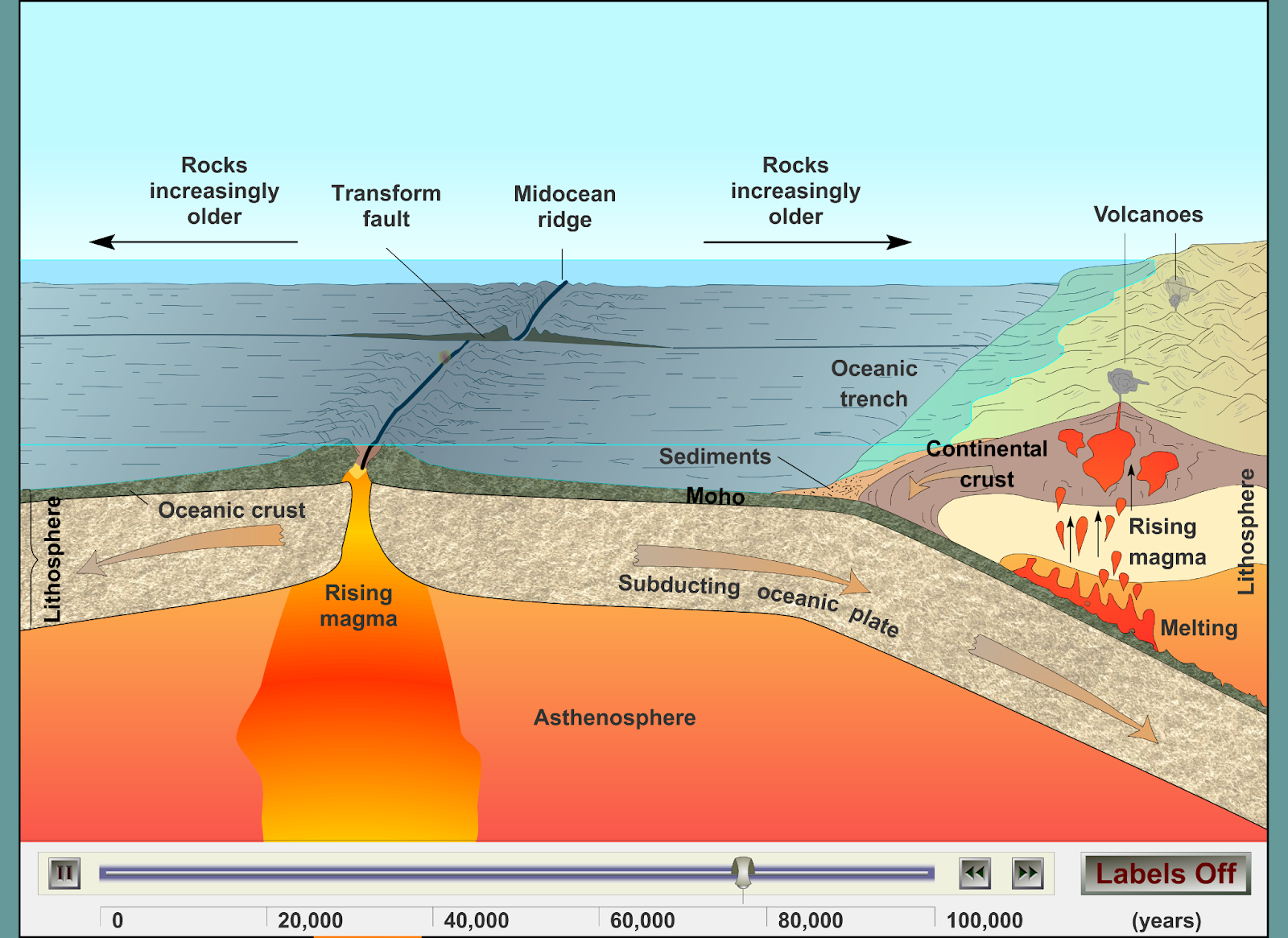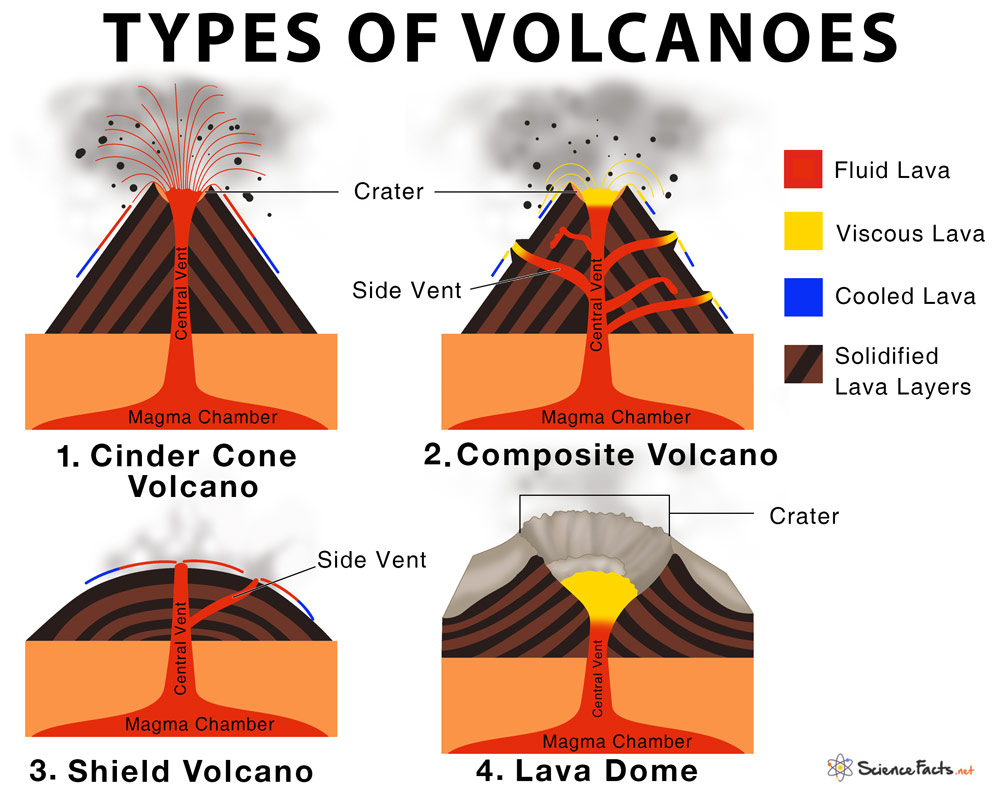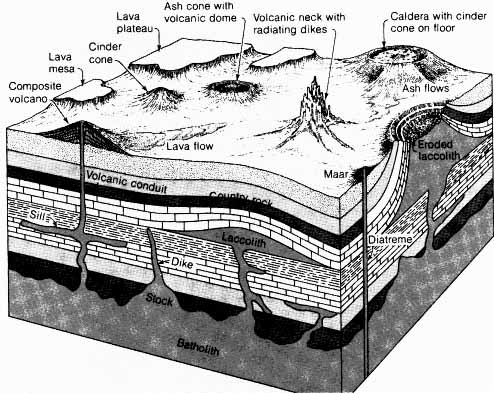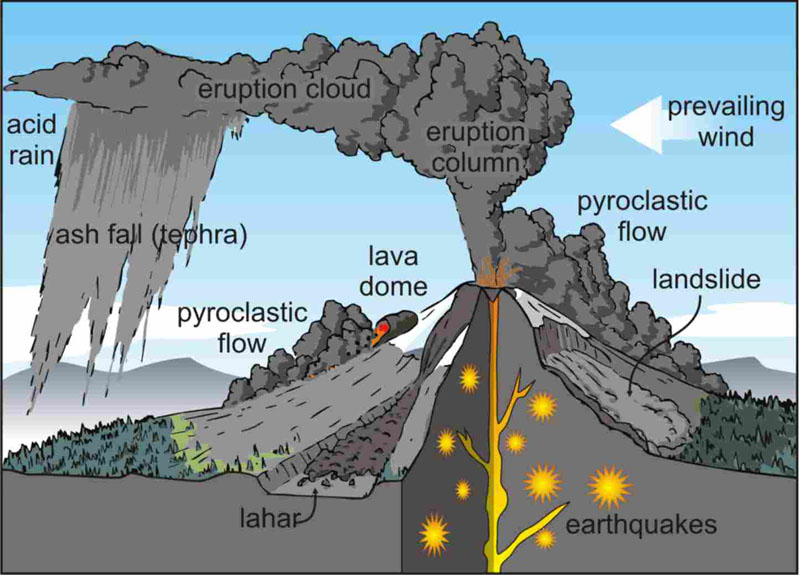
What are Volcanoes?
Volcanoes are openings in the Earth's crust through which molten rock, volcanic ash, and gases are released from a reservoir of magma beneath the surface. They are commonly found in areas where the Earth's tectonic plates are either moving apart (diverging) or colliding with each other (converging).
While many volcanoes are located underwater, there are also numerous ones on land.
When the pressure from the magma chamber beneath the surface becomes too great, it causes an eruption. During an eruption, molten lava flows out of the volcano, while volcanic ash and gases are expelled into the atmosphere. The lava cools and solidifies, forming new land masses over time. Volcanoes play a significant role in shaping the Earth's surface and can have both positive and negative impacts on the environment and human populations. They create fertile soil for agriculture, provide geothermal energy resources, and contribute to the formation of new land.
However, volcanic eruptions can also be destructive, causing damage to surrounding areas, releasing harmful gases, and triggering other natural disasters such as landslides and tsunamis.
Why do they form?
Volcanoes form in specific geological settings, primarily at plate boundaries where tectonic plates interact.
The three main types of plate boundaries where volcanoes occur are:
- Divergent Boundaries: These are areas where tectonic plates are moving apart, creating a gap or rift between them. Magma from the underlying mantle rises to fill this gap, forming volcanic activity. The Mid-Atlantic Ridge and the East African Rift are examples of divergent plate boundaries where volcanic activity is common.
- Convergent Boundaries: These are areas where tectonic plates collide, with one plate subducting beneath the other. The subducting plate sinks into the Earth's mantle, and as it does, it heats up and releases water and other volatiles. These substances rise and trigger melting in the mantle, leading to the formation of magma chambers and volcanic eruptions. The Pacific Ring of Fire, including the subduction zones along the coasts of Japan, Chile, and the Philippines, is known for its volcanic activity.
- Hotspots: Hotspots are localized areas of intense volcanic activity that occur away from plate boundaries. These are believed to be caused by plumes of hot mantle material rising from deep within the Earth. As the tectonic plates move over the stationary hotspot, volcanic activity occurs. The Hawaiian Islands and Yellowstone National Park in the United States are examples of areas with hotspot volcanism.

What are their types?
Volcanoes are classified into three categories based on their activity:
- Active Volcanoes: These are volcanoes that have erupted recently or are showing signs of volcanic activity. There is a possibility that they may erupt again in the near future.
- Dormant Volcanoes: Dormant volcanoes are those that have not erupted for a long time but still have the potential to become active again. Although they are currently inactive, there is a chance that they could erupt in the future.
- Extinct Volcanoes: Extinct volcanoes are those that have not erupted in thousands of years and are considered to be permanently inactive. There is no possibility of them erupting again.
These categories help scientists and researchers assess the level of volcanic activity and the potential risks associated with different volcanoes.
Types of volcanoes on bases of nature of eruption
- Shield volcanoes: These volcanoes have broad, gently sloping sides and are formed by repeated lava flows. They have a low viscosity lava that spreads easily and covers large areas. Shield volcanoes are typically not very explosive and can grow to be quite large.
- Composite or stratovolcanoes: These volcanoes have steep sides and are built up by alternating layers of lava flows and ash deposits. They are known for their explosive eruptions and can release pyroclastic material (hot ash, rocks, and gas) during eruptions. Composite volcanoes often have a conical shape and can be very tall.
- Cinder cone volcanoes: These are small, steep-sided volcanoes that are formed from the accumulation of volcanic fragments called cinders or scoria. They have a simple cone shape and are usually the result of short, explosive eruptions. Cinder cone volcanoes are typically not very large in size.
- Lava domes: These are created when thick lava erupts and accumulates near the volcanic vent, forming a steep-sided mound. These domes are a result of slow eruptions with highly viscous lava. They can be found within the crater of a previous volcanic eruption. While they can have explosive eruptions like composite volcanoes, the lava from lava domes usually does not travel far from the vent.

Each type of volcano has its own unique characteristics and eruption patterns, contributing to the diverse volcanic landscapes we see around the world.
What are Volcanic Landforms?
Volcanic landforms are unique geological features that are formed as a result of volcanic activity. They offer valuable insights into the geological history of an area and provide evidence of past volcanic eruptions.
Here's a closer look at some of the key volcanic landforms:
- Volcanic Cones: Volcanic cones are the most recognizable landforms associated with volcanoes. They are cone-shaped mountains formed by the accumulation of erupted materials, such as lava flows, ash, and pyroclastic deposits. The shape and size of volcanic cones can vary depending on the eruption style and the type of volcano.
- Craters: Craters are bowl-shaped depressions found at the summit of many volcanoes. They are formed by explosive eruptions that remove material from the volcano's summit and create a large, circular opening. Craters can be relatively small or large, and they often contain a central vent or a lava dome.
- Calderas: Calderas are enormous volcanic depressions that form when a volcano collapses after a massive eruption or when the magma chamber is emptied. Calderas can have diameters ranging from a few kilometres to tens of kilometres. They often exhibit steep walls and may contain smaller volcanic cones or lakes within their boundaries.
- Lava Domes: Lava domes are formed when highly viscous lava accumulates near the volcanic vent. They are characterised by their steep-sided mounds and can grow slowly over time as successive eruptions add more lava. Lava domes are commonly associated with explosive eruptions and can be found within craters or on the flanks of volcanoes.
- Volcanic Islands: Volcanic islands are landforms that emerge from the ocean floor as a result of volcanic activity. They are formed by a series of volcanic eruptions that build up layers of lava and volcanic materials. Over time, these eruptions create an island that may continue to grow or erode depending on the volcanic activity and erosional forces.
By examining the composition and layering of volcanic deposits, scientists can reconstruct past eruptions and understand the geological processes at work. Volcanic landforms also offer insights into the types of magma involved, eruption styles, and the evolution of volcanic systems. This knowledge is essential for hazard assessment, land management, and the understanding of Earth's dynamic processes.

Role of volcanoes in Intrusive rock formations
Intrusive rocks are formed when molten magma rises from deep within the Earth's crust and solidifies underground. As the magma cools and crystallises, it forms intrusive rock formations known as intrusions. These intrusions can take on various shapes and sizes and are classified into different types based on their specific characteristics.
Here's a closer look at some of the common types of intrusive rocks:
- Batholiths: Batholiths are the largest intrusive rock formations, often covering vast areas of several hundred square kilometres. They are composed of coarse-grained igneous rocks, such as granite, and are typically formed at great depths within the Earth's crust. Batholiths are often exposed through erosion, creating impressive mountainous landscapes.
- Dikes: Dikes are narrow, vertical or near-vertical intrusions that cut across pre-existing rock layers. They are usually composed of fine-grained igneous rocks, such as basalt or diabase. Dikes are formed when magma is injected into fractures or cracks in the surrounding rocks and solidifies, creating a wall-like feature.
- Sills: Sills are horizontal or near-horizontal intrusions that occur between existing rock layers. They are parallel to the surrounding rock layers and are often found as tabular bodies. Sills are typically composed of fine-grained rocks, such as basalt or dolerite, and are formed when magma is injected along the bedding planes of the host rock and solidifies.
- Laccoliths: Laccoliths are lens-shaped intrusions that cause the overlying rocks to bulge upwards. They are formed when magma is injected between layers of sedimentary rock and spreads laterally, creating a mushroom-like shape. Laccoliths are typically composed of intermediate to felsic igneous rocks, such as granite or diorite.
- Volcanic Necks: Volcanic necks are formed when the solidified magma within a volcano's conduit becomes exposed through erosion. They are vertical, pipe-like intrusions that remain after the surrounding volcanic material has eroded away. Volcanic necks are often composed of more resistant igneous rocks, such as basalt or rhyolite.
These formations offer insights into the composition and characteristics of magmas, the timing and duration of magma emplacement, and the deformation and uplift of the surrounding rocks. Intrusive rocks also play a significant role in the formation of mineral deposits and can have economic importance as sources of valuable resources.
Volcanic eruptions in Indian Subcontinent
One of the active volcanoes in India is Barren Island, located in the Andaman Sea. It is the only confirmed active volcano in South Asia and has witnessed eruptions in recent history. Barren Island is part of the Andaman and Nicobar Islands, which is a Union Territory of India.
What are Volcanic Hazards?
Volcanic hazards refer to the potential dangers and risks associated with volcanic eruptions. They can have severe consequences for both human populations and the surrounding environment.
Here are some key volcanic hazards:

- Lava Flows: During an eruption, molten lava can flow down the sides of a volcano, moving at varying speeds depending on its viscosity. Lava flows can destroy structures, vegetation, and infrastructure in their path, posing a direct threat to nearby communities.
- Pyroclastic Flows: These are high-speed, superheated currents of gas, ash, and volcanic materials that rush down the slopes of a volcano. Pyroclastic flows can travel at incredible speeds, engulfing everything in their way. They are extremely destructive and can cause severe burns, asphyxiation, and damage to infrastructure.
- Volcanic Ashfall: Volcanic eruptions release vast amounts of ash into the atmosphere, which can then fall to the ground as ashfall. Volcanic ash is composed of fine particles that can cause respiratory issues, damage crops, disrupt transportation systems (such as aircraft engines), and lead to the collapse of structures under its weight.
- Volcanic Gases: Volcanoes emit various gases, including sulphur dioxide, carbon dioxide, hydrogen sulphide, and others. These gases can be toxic and pose risks to human health if inhaled in high concentrations. They can also contribute to air pollution and have environmental impacts.
- Lahars (Mudflows): Lahars occur when volcanic material mixes with water, either from heavy rainfall or the melting of snow and ice on the volcano. This mixture creates fast-moving mudflows that can travel down valleys and river channels, causing significant damage to infrastructure and communities in their path.
- Volcanic Landslides: The instability of volcanic slopes can lead to landslides, where large volumes of rock, debris, and ash collapse and slide down the volcano's flanks. Volcanic landslides can trigger tsunamis if they enter bodies of water, and they can also generate pyroclastic flows and lahars.
Understanding these volcanic hazards is crucial for mitigating risks and ensuring the safety of nearby communities. Volcanic monitoring, early warning systems, hazard mapping, and evacuation plans are essential for managing these hazards effectively.
Why are volcanic eruptions significant?
Volcanoes have played a crucial role in shaping the Earth's surface and creating diverse landscapes. They have contributed significantly to the formation of mountains, craters, and lava rivers. These dynamic geological features have not only shaped the physical characteristics of our planet but have also had a profound impact on the development of life.
One of the key contributions of volcanoes is the creation of fertile soils. As volcanic rocks weather and break down over time, they release essential nutrients into the surrounding areas. These nutrient-rich soils are incredibly fertile and provide a favourable environment for plants to grow and thrive. The availability of such fertile soils has been instrumental in supporting the growth of vegetation and sustaining diverse ecosystems.
The fertility of volcanic soils has also played a significant role in the development of human civilizations. Ancient civilizations recognized the benefits of settling near volcanic areas due to the fertile lands for agriculture. Volcanic regions have provided ideal conditions for growing crops, leading to prosperous agricultural societies throughout history.
Additionally, volcanic eruptions release gases, such as carbon dioxide and water vapour, which contribute to the Earth's atmospheric composition. These volcanic emissions play a crucial role in regulating the planet's climate and influencing weather patterns.
In summary, volcanoes have acted as Earth's geologic architects, shaping its landscapes and creating fertile soils that have supported the growth of life. They have been instrumental in the development of civilizations and have had a lasting impact on the planet's physical and ecological systems.


